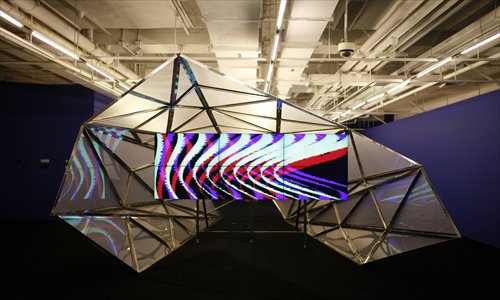The Screen Generation

A digital application called Pure is on display at the exhibition.
From televisions and computers to mobile phones and the cinema, we are familiar with screens. But the futuristic screen currently on display at K11 Art Mall invites viewers to look beyond the flat surface and consider our relationship with screens.
The exhibition, named The Screen Generation, is being held at the chi K11 Art Space until February 15. A white semitransparent polyhedron installation is arranged in the center of a blue space. On the broader end of the installation, visitors can see a screen inside, which displays six works in intervals of four minutes.
The six works - named Soft, Hard, Repeatedly, Pure, Static and Noise - are digital applications written by Shanghai-based new media artist Xu Wenkai, who chose the six keywords to define the characteristics of screens as well as humans.

The white semitransparent polyhedron installation displayed at K11 Art Space Photos: Cai Xianmin/GT
Xu believes that in this information era, humans are in some way constituted by the information that screens project, and people have become, like screens, information nodes in the information transmission process.
Take Repeatedly as an example; the app is actually built upon a small 40-frame GIF image featuring moving black dots against a white backdrop, and through multiple repetitions Xu creates a visually vast space.
"In this case, simple repetitions easily mislead our logic with a deceptive visual experience, which is quite cunning and personificative actually," said the artist. "This kind of method is very common in the logic of information transmission, which holds true for both screens and humans."
Meanwhile, Hard, which borrows a video of sci-fi novelist Isaac Asimov explaining his Three Laws of Robotics, showcases the hardness and abruptness of destructive forces in information transmission by covering some of Asimov's speech with beeps and re-matching the video with automatically generated subtitles from youtube.com. The new subtitles can barely express the writer's theory anymore.
The white installation, according to Xu, is his interpretation of what a screen might look like in the future, making a sharp contrast to the normal screens we see today. Also on view at the exhibition is another screen on a wall depicting how the installation gradually took shape.
Born in 1984, Xu graduated from Wuhan University's School of Computer Science in 2007. Since 2006, he has been working on translating new media art criticism by Belgian blogger Régine Debatty into Chinese on his website we-make-money-not-art.com, and has created various series of works through computer processing.
"There are not many contemporary artists who have impressed me a lot, but I think what influences me and my creative process most deeply are the changes made by the Internet on social structures," said the Xi'an-born artist.
Xu has explored the existence and characteristics of data and data streams in his former series, such as Cybernetics and Placebo, which are more about rationality. However, this ongoing exhibition, which is based on his personal perception of screens, aims to provide the audience with a "soft" experience.